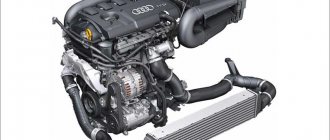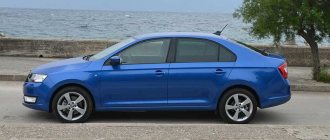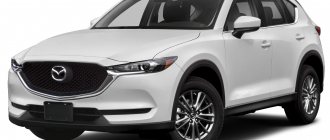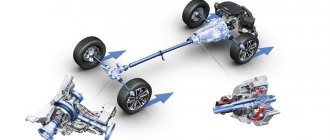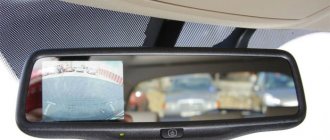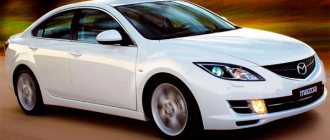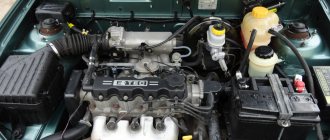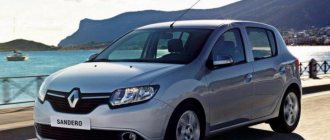First presentation of the car
The family car Volkswagen Turan belongs to the class of compact minivans (MPV), the model was first presented in the winter of 2003 at the international auto show in Amsterdam.
The platform of the new car was the Golf 5; the car was supplied in 5- and 7-seater versions; in some countries, such as Japan, it is known as the Golf Touran.
The name Turan combines two words – “Tur” and “Sharan”, and indeed, this compact van has a significant external resemblance to the VW Sharan, but is characterized by more modest dimensions.
Distinctive features of the model are the presence of a rear four-link suspension, electric power steering, and a seat belt reminder system for the front passenger and driver.
First generation Volkswagen Touran
The first generation German compact van was produced for more than 11 years, produced not only in Germany (Wolfsburg), but also in Indonesia (Jakarta) and China (Anting).
During its entire existence on the assembly line, the car was restyled twice - in 2006 and 2010, Turan 2010 received an updated platform created on the basis of the Golf-6 (PQ35).
In the new version of the car, aerodynamics were significantly improved, xenon headlights and an adaptive suspension system were used. The line of Volkswagen Turan-1 engines is quite diverse, it includes both gasoline internal combustion engines and diesel engines with a volume of 1.2 to 2.0 L, with a power of 101 to 174 horsepower.
The minivan is equipped with a five- and six-speed manual transmission, an automatic transmission-6 Tiptronic, and since 2008, a 7-speed DSG “robot” with 2 “dry” clutches has been installed on the car.
Although the German car looks very modest and has small dimensions, it is characterized by a high level of safety, reliability and good equipment, but is produced only in a front-wheel drive version.
Review of Volkswagen Touran 2.0 TDI (2005)
Good day everyone! So I raised my hand to write a review about my iron horse. I often go to the site and read reviews, but I kept putting off writing my own. And now I have a little time - so I decided.
A little over a year ago we decided to exchange our VW Vento family car for something fresher and more spacious. I’ll say right away that I was very pleased with the experience of operating my Vento, so I was partial to European brands. Options were considered in the class of compact vans (Opel Zafira Meriva, Ford C-max, VW Touran, Mazda MPV) and initially SUVs (Nissan Qashkai, VW Tiguan, Hyundai Tucson, Mitsubishi Outlander Outlander XL). When we decided on the amount of available funds (maximum 700 kilorubles), many options disappeared by themselves. The SUVs disappeared entirely, but left a strong impression. I really liked the VW Tiguan and Outlander XL, but they remained a dream. After traveling around showrooms, looking and asking prices, I realized that I didn’t want to take a new but empty car. Even then I settled on Tourane. Then there was a long search for exactly the right configuration. And finally, I became the proud owner of a VW Touran with a 2-liter turbodiesel, DSG gearbox, black pearl color and very abundant equipment.
First, about the sad thing, about operating costs. I drove a little more than 40 thousand km in a year. At the time of purchase, the mileage was 81,000 km, which, in my opinion, is suspiciously low for an almost four-year-old car. I think it was wound up almost twice. This is confirmed by a slight rattling sound that appeared a month later in the automatic transmission area. The result is the replacement of the dual-mass flywheel - a problem for cars with DSG. Occurs at 150-200 thousand kilometers. They say that since 2007 VW has solved this problem. My wallet was empty by almost 25 thousand rubles. Thank God the unexpected expenses ended there. Among the expected things were the replacement of the timing belt, oil in the box, rear brake pads and struts all around. I changed the struts mainly for my own peace of mind rather than out of necessity. I also had to change the radiator (it was pierced by a stone on the highway) and the overrunning clutch with tensioner roller (it got stuck). In terms of the cost of spare parts, it’s certainly not a Vento, but it’s not a Mercedes either. I was a little disappointed by the cost of periodic maintenance: changing the oil, fuel, oil, cabin and air filters costs around 5.5 thousand rubles including labor. On a diesel engine you have to change it every 8000 km. The consumption of diesel fuel was pleasantly pleasing: even if you want to give it more gas, it does not exceed 10 liters - in the city, on the highway with quiet driving - 6.0 liters, at speeds of 150-160 - about 8 liters. I measured it myself at gas stations. The on-board computer lies by 15 percent, of course, downwards. In winter, consumption increases by 1 liter due to heating and Webasto. By the way, when I bought the car, they scared me about the diesel engine - it’s noisy, it stinks, it won’t start in winter, it doesn’t heat well. Of all the horror stories, I only agree with the last one, but in my case it was solved by the presence of an autonomous heater. As for the rest, I completely disagree.
Well, now about the good stuff. I have never been disappointed in the car. I travel a lot, around the city on average 100 km a day, on the highway I travel to Moscow and the Tambov region, I have driven more than 40 thousand km in a year. Didn't let me down, always took me to my destination. 140 hp Enough for a car. It accelerates quickly both from a standstill and on the highway, leaving many passenger cars far behind when overtaking, despite its considerable weight - 1620 kg without load. Thanks to the weight, it goes very well in a straight line, like on rails. It doesn’t roll much when cornering, but you have to pay for it with the stiffness of the suspension; you can feel every joint. The handling is excellent, I didn’t notice any unpredictable reactions. We must pay tribute to VW - even the Turan base includes an ESP stabilization system, which makes driving easier in difficult weather conditions. But at the same time they saved on noise, you can hear everything. The wheels can be heard already from 60 km/h, the engine and wind are somewhere from 120. But the noise is not annoying, it starts to get noticeable only from 140 km/h. I accelerated the car to 180, the reserve remains, it goes confidently.
The salon captivated me with its thoughtfulness. Lots of drawers, pockets, niches. The seats can be folded or removed in a couple of minutes. The rear seat is comfortable for three full-size passengers. The only thing is that the seating position of the passengers is quite vertical; in order to tilt the back of the rear seat, you need to move the seat itself forward, which is not always possible. The trunk is very spacious. Having taken out the rear seats, we transported the shower stall from the store, although in a disassembled state, the thing was quite voluminous. The driver's seating position is high, it was unusual after a sedan, but now, on the contrary, I sit in my brother's Accent as if on the floor. The gas pedal is a floor pedal, which turned out to be very convenient on long trips. And in general, the car seems to be designed for long-distance forays. Having traveled more than a thousand in a day, fatigue is minimal. Climate control, navigation, rear parking sensors, heated front seats - things, although not essential, make life much easier.
I was pleasantly surprised by the performance of the engine in combination with the DSG; it pulls well in all modes. I tried driving in Sport mode - I didn’t feel any particular advantages, except for an increase in consumption. That's why I drive as usual. There is a tiptronic, but I have never used it.
The ground clearance was upset. On my European car it’s 13 cm, on cars with a package for bad roads it’s a couple of cm more. Because of this, I ran aground twice. The lowest place is something like a beam under the box, so it sat on the track. The engine protection is metal, which is a plus for Russia.
Well, that's all I wanted to write about. Don't take this review as an ode to praise, but I really like the car.
Second generation Turan
The new Touran-2 debuted at the Geneva Motor Show in the spring of 2015, the car was based on the MQB platform; the Audi TT/ Q2/ A3 Mk3, Volkswagen Tiguan/ Passat-8, Golf-7, Skoda Octavia-3/ Superb and others were also created on this basis brands.
Compared to the previous model, the updated compact van has slightly increased in size (by 130 mm); the line of power units has been supplemented with four internal combustion engines, which are distinguished by very economical fuel consumption and a minimal level of CO in the exhaust gases.
The new Volkswagen Turan has a galvanized body, has improved aerodynamics, and looks like a VW Multivan.
By increasing the wheelbase to 2791 mm, length and the presence of many additional functions, the compact van has become even more comfortable to use. This model is very popular in Europe, but, unfortunately, is not officially supplied to Russia.
Used Volkswagen Touran l: underrated DSGs and double-charging nightmares
Transmission
If you are a fan of mechanics, then Volkswagen will give you the opportunity to buy a Touran with any engine except the 1.4 TSI version with 170 hp.
and the CAVB index. All other variants have a five- or six-speed manual transmission as standard equipment. Fans of “classic” automatic transmissions were less fortunate: it was found only in versions with 1.6 and 2.0 FSI engines until the first restyling in 2006. As a result, it is impossible to find a car with such an automatic transmission.
With the DSG “robot” there are already significantly more of them. Diesel engines work strictly with the DQ250 with an oil bath clutch, and the gearbox as a whole is quite reliable. But for gasoline engines the situation is more complicated. The DQ250 can only be found with 1.4 TSI engines with 170 hp. on cars produced before 2008, after which they installed DQ200. To be honest, the early versions of this box fully deserved all the unflattering epithets that were awarded to it. Now the situation is being corrected, but on older cars the DSG may still have old bearings for the shift forks and old mechatronics, which automatically means a very high chance of serious troubles .
Volkswagen Touran '2010–15
Since the drive can only be front-wheel drive, there is no need to expect any special problems in the transmission. Except that sometimes it can upset the internal CV joint on cars with high mileage. If it crackles at the start, then the real mileage of the car is almost certainly 250-300 thousand or even more, no matter what the odometer says.
With powerful engines and DSG, external CV joints also last noticeably less than with a manual transmission.
The five-speed manual gearbox, which was installed with eight-valve 1.6-liter engines before restyling, with mileage over 200 thousand can cause failure of the bearings and differential. When purchasing, it is better to listen to the gearbox on a lift.
In almost all six-speed manual transmissions, with rare oil changes and long winter slippages, the differential can “go for a walk” right through the housing. But this is a relatively rare phenomenon that requires the coincidence of a number of negative factors.
But the wear and tear of the switching mechanism in all gearboxes over 250-300 thousand runs is rather inevitable. The backlash at this point has passed the comfortable limit. Usually replacing the rocker bushing (VAG 1K0 711 699 A) improves the situation, but sometimes replacing or restoring the intermediate lever (1K0 711 203 H) helps a lot. The switching mechanism on the box itself is often worn out, and with a six-speed manual transmission this scenario is more common.
Let me remind you that dual-mass flywheels are a part with a limited service life. If there are knocking noises, it can be replaced or repaired, but it should not be brought to the point of self-disassembly: both the manual transmission housing and the starter will be damaged.
Volkswagen Touran '2010–15
The extremely rare automatic transmission 09G (aka Aisin TF61SN) was paired with FSI engines before the first restyling. The box is characterized by high reliability of the mechanical part and an equally high failure rate due to rare oil changes and contamination and overheating of the valve body. With frequent oil changes and a modified cooling system, the automatic transmission shows a very good service life, more than 300 thousand kilometers. With standard cooling and with rare oil changes, after hundreds of thousands the valve body will twitch.
The bulk of “automated” VW Tourans are equipped with a seven-speed preselective DSG gearbox of the DQ200 series . These boxes, produced before 2011-2012, have obvious errors both in the mechanical part and in the electronic-hydraulic unit (mechatronics). Moreover, hardware errors occur quite often and lead to costly consequences. At a minimum, the gearbox necessarily requires replacing the shift fork bearings and installing a modified differential.
Mechatronics also has a lot of problems. Now you can purchase modified new versions at a price of about 80 thousand rubles, or you can repair the old one. But a few years ago, repairs were carried out in a completely artisanal manner, and the price of a new part was several hundred thousand rubles. Today, most of the negativity in this regard, accumulated on social networks and forums, is no longer very relevant. But still, the box of back issues remains potentially problematic.
The DSG versions produced in 2013-2015 are noticeably more reliable. If you also take care of the clutch, handling traction correctly, and do not allow the differential to break, then a service life of more than 150 thousand kilometers is guaranteed.
After this run, you will have to clean the mechatronics, change the bearings of the mechanical part, check the forks, the condition of the differential and, of course, the LuK clutch pack and the dual-mass flywheel.
Unfortunately, the work is not always carried out efficiently. It is not uncommon for problems to arise again after the first major repair.
The two compressors are controlled by a complex throttle valve system, and the intake piping is more than one and a half meters long with more than a dozen connections.
One of the clear advantages in comparison with the very common CAXA (122 hp) is the presence of a full-fledged air-to-air intercooler, which works efficiently, is little polluted by the crankcase ventilation system and does not depend on the operation of the electric pump.
Cons - everything else. That is, the complexity of the design, age, the high price of a number of components, the high cost of control system errors and the consequences of poor quality maintenance. Of course, the traction and consumption of a working engine are very good. Better than new generations of EA211 engines with advanced turbocharging systems. But, unfortunately, the disadvantages outweigh.
When purchasing a motor, it definitely requires careful diagnostics, checking the operation of two compressors and carefully listening to the timing system.
Motors with standard gas equipment of the CDGA series turned out to be very successful. These engines have a thermostat and a reinforced piston group and valves. They delight with a consistently high service life, and it often takes more than 300 thousand before the first intervention in the piston. The timing belt here also lasts longer, but remember that LPG cylinders corrode and explode.
The supercharged 1.2 TSI engines that appeared after restyling combine simplicity and reliability, but only if they have a modified chain and wastegate actuator.
There is an eight-valve cylinder head here, simpler and stronger than the one used in 1.4-liter TSI engines. The chain on early engines was famous for its extremely low service life, slipping after 30 thousand mileage. But those engines have been modernized a long time ago, and new kits have a service life of 120 thousand kilometers. And since 2013, the chains have become even more reliable.
Volkswagen Touran '2006-10
Their piston group is strong, and the engines themselves are not prone to detonation at all.
Turbine problems are mainly related to the use of the wastegate motor. Failure of the V565 actuator is not very predictable, and sometimes it can be fixed with little effort by simply eliminating the gaps in the drive. Sometimes the solenoid needs to be replaced. Fortunately, it is now available as a separate part, and the entire turbine is not replaced.
Diesel engines
Timing belt cost 2.0
for the original
8,225 rubles
Diesel engines can be divided into two groups. Before the second restyling, engines with pump injectors of the EA188 family with a volume of 1.9 and 2.0 liters were installed. And if for the first engines the main problems are related precisely to the wear of the camshafts, service life and adjustment of the pump injectors, then the two-liter engines also have problems with cracking of the cylinder head and pistons. The injectors for two-liter cars may not be electromagnetic, but piezoelectric, which are significantly more expensive and have less resource.
Other troubles are relatively inexpensive. Fortunately, not all modifications have a particulate filter (you can look without it, so as not to waste money on turning it off ), and the EGR here is quite conservative and therefore lasts a long time and pollutes the intake slowly.
Since 2010, we have supplied engines with common rail injection of the EA189 series with a volume of 1.6 and 2.0 liters. They have much fewer questions about fuel equipment, it is reliable and can be easily diagnosed, but the EGR fails much faster.
Volkswagen Touran '2006-10
Among diesel engines, the most important thing to be wary of are two-liter diesel engines with 16-valve cylinder heads and pump injectors. They are too forced, and their cylinder head casting is weak, which causes many problems.
Very common 1.9 TDI in 90-105 hp variants. extremely reliable, especially the BLS/BXJ versions. The AVQ and BXE motors are also good, but they are slightly inferior to the first two.
Common minor troubles are oil leaks, which arise mainly due to breakdowns of the crankcase ventilation elements: with age, plastic tubes crack and rubber ones “rot.” Antifreeze leaks most often occur through the tee between the third and fourth cylinders. The drive of additional units suffers from a short life of the tensioner roller, which sometimes leads to the belt slipping and breaking. In this case, the remnants of the belt get under the timing belt casing and lead to “Stalingrad”. The belt and roller have to be changed frequently, and their condition must be monitored constantly.
Among the serious problems, we note the difficult to detect wear of the crankshaft liners after 200-250 thousand mileage. Most often it is found on cars that like to drive in sixth gear with a load at idle. An automatic transmission does not allow such a mode, but with a manual it is quite possible to drive like this. Since the motors are very vibration-loaded, knocking noises are difficult to detect at an early stage. Every second timing belt replacement (at least once every 90 thousand kilometers), it is advisable to remove the pan and check the main and connecting rod bearings. Moreover, it would be a good idea for the connecting rod to change the bolts at the same time.
Oil starvation destroys not only the camshaft, but also the pump injectors that are driven by it. In addition, it leads to scuffing of rockers, bushings and cylinder head beds.
The pump injectors themselves are expensive, about 50 thousand rubles each, and are not particularly reliable. Bad fuel will destroy them quickly, and seal leaks will begin to affect starting performance over time. In addition, they sharply increase the wear of the plunger pair, which in this case runs “dry” during startup. If the engine does not start immediately after a couple of days of inactivity, then most likely the injectors need to be rebuilt. Fortunately, they are quite amenable to repair, although this is not cheap, and quality control of the work is difficult.
Of course, it is worth monitoring the condition of the oil pump. Its service life is often no more than 200 thousand kilometers, so checking its condition is a mandatory procedure when replacing the timing belt.
In addition to all the problems with 1.9-liter engines on two-liter 16-valve diesel engines, problems with cylinder head cracks are added. If you really want to buy such a car, then take the time to wait until the engine is completely warmed up and check if there are any gases in the expansion tank after gassing.
When there are leaks in the pump injectors, the compression rings of the pistons coke, causing oil consumption and a very real chance of seeing what happens when the engine runs too fast. The emergency intake flap usually becomes overgrown with dirt and does not work on older cars.
Volkswagen CrossTouran '2010–15
The EGR on these engines is somewhat more loaded, and problems with it arise more often. Yes, and pump injectors on engines produced before 2006 come with a piezoelectric valve. For most cars, they were replaced, along with the control unit, with conventional electromagnetic ones, but there are also unconverted copies. The tendency of piezo valves to leak in a de-energized state is not as fatal as on systems with common rail, but the entire nozzle will have to be replaced, and this is expensive. It would be better to replace all four injectors along with the harness and control module.
Since the engines are more powerful than the 1.9-liter ones, the load on the oil pump is even higher. And you need to carefully monitor his condition. To do this, it is advisable to remove the pan every 30-60 thousand kilometers. Especially if there is an old modification with a chain drive rather than gears. On engines produced before 2007, it is better to replace the oil pump with a new one with a shaft drive.
Unfortunately, it is impossible to predict the imminent demise of the oil pump based on indirect signs. The pressure drop can be very small almost until the pump fails, and the faulty unit does not produce any unnecessary sounds. And if the crankshaft starts knocking, it’s too late to work on the oil pump. Here you will have to do a lot of repairs, at least with the restoration of the crankshaft and turbine.
Volkswagen Touran '2006–10
Radiator cost
for the original
17,492 rubles
Newer diesel engines of the EA288 series are definitely more reliable. But they also have very delicate injectors, and on 1.6-liter engines of early releases there are generally piezo injectors that are prone to failure after five to six years of operation. They easily “flood” the cylinder, so you can not only burn out the piston, but also catch a hydraulic shock.
There are no problems with oil pressure in the cylinder head, but liners on older engines are still at risk. At the first suspicion or knock, they must be changed, and to extend their service life, do not drive them at too low speeds.
conclusions
Touran was produced for many years, and during this period the car changed thoroughly. The first restyling mainly consisted of working on bugs. The body hardware has become better, and the mechanics have become a little better.
The second restyling turned out to be more serious than the first. All external panels of the Touran were replaced, the anti-corrosion treatment scheme was seriously reworked, removing the main weak points. The interior has been noticeably updated, the range of engines and gearboxes has changed. Even if the codes of gasoline engines are the same after this restyling, there are still changes, and there should be clearly fewer problems.
Volkswagen Touran '2006–10
The new series of diesel engines has completely resolved issues with the reliability of powerful versions, so if you need a powerful diesel engine, then look for a car only after the second restyling.
In principle, if you need a car for every day, then you shouldn’t buy a car before 2010 at all: they usually already have huge mileage, the condition is not very good, and there are too many potential problems with engines and gearboxes.
It’s better to forget about the “regular” automatic transmission. This is rare, and the FSI motors that go into the load are too unreliable. Moreover, the six-speed DSG on later production cars is not much worse in reliability, but clearly better in dynamics.
Among all the options, the cars after the 2010 restyling with diesel engines and 1.2 TSI look best. Moreover, it is the second restyling cars with 1.2 engines that are very underestimated. In essence, this is a modern version of BSE, combining simplicity and low cost of possible repairs, but with slightly less reliability.
Diesel versions of the Touran are noticeably more expensive, but with long mileage they are noticeably more reliable than cars with twin-supercharged 1.4 TSI engines.
Expert opinion
In Russia, compact vans have always been treated rather coldly. Even commercials with happy families going on a trip to the country, and “Jeep-like” modifications for typical Russian roads, did not help. The German “kvadratish, praktish, gut” in the person of the first generation Volkswagen Touran was no exception - on the secondary market there are hardly two hundred offers, all over Russia. Moreover, before its appearance, the merciless and already small market of compact vans was chosen by Renault Scenic, Opel Zafira and Citroen Xsara Picasso.
Nevertheless, the first generation Touran is being bought. And not only Volkswagen fans. The most common modification among pre-restyling cars is the 1.9 TDI on a “robot”; among more recent restyled cars there is a modern Volkswagen classic represented by the 1.4 TSI, again on a “robot”. All cars have front-axle drive, but, alas, there are no all-wheel drive versions of 4Motion. Although some especially handy enthusiasts are correcting this situation. Therefore, if you come across an all-wheel drive Touran, you should know that this is a real hand-made product.
The risk of running into a car after a taxi is quite small, since the use of Touran in passenger transportation began with the advent of its second generation. But there is a risk of buying a car with low mileage, especially if you are looking at a pure European from Germany, Lithuania or Latvia, from where they are driven with the “500 plus” highway mileage usual for such cars.
Prices for burgher compact vans are quite reasonable - for 350-360 thousand rubles you can find a pre-restyling car. Restyling costs significantly more - on average about 420 thousand for a more or less decent copy.
Interior
The interior of the family car is quite spacious, with plenty of space for passengers sitting behind the driver.
The second row seats can move back and forth, but the backrests are tilt adjustable only on 7-seater Turans.
Retractable tables are provided behind the front seats, and here you can have lunch on the road, and with the inclined position of this device, it is convenient to place a tablet computer on it.
There are various compartments and niches for small things and objects; they are located in the door pockets, armrest, on the instrument panel, and in the ceiling trim.
Double row version.
The third row of seats is designed for two passengers of not too large build; there are backlight lights on the rear ceiling.
Trunk
With the standard placement of the rear sofa, the luggage compartment volume is 743 liters, and this figure is considered one of the best in the MPV class.
Keyless access makes it easy to open the back door if your hands are busy, and in general the trunk itself is quite functional - there are many hooks and fastenings for bags, there is a flashlight with a magnet, backlight, 12 and 220 Volt sockets.
In the five-seater version, with the rear row of seats folded down, the volume of useful cargo space increases to 1980 liters; in the 7-seater version, this figure is 1857 liters.
The backrests fold into an almost flat floor, which allows you to conveniently place the maximum amount of different luggage.
VW Touran 1.4 TSI Ecofuel: think smart
Low emissions and attractive fuel consumption are the main advantages of a family van specially prepared to run on natural gas. However, they are contemplating a higher market price. Is it worth it?
Statistics show that approximately 30.5 million gasoline-powered vehicles drive on German streets. However, only 71,500 are fueled with methane fuel, and very few of them are factory prepared for this.
Environmentally friendly and economical on the road
The VW Touran 1.4 TSI Ecofuel, equipped with a compressor and twin turbocharging, develops 150 hp. and 220 Nm. The car is 10 horsepower more powerful than a conventional 1.4-liter gasoline engine. Traveling in a family van is a pleasure, especially when it's environmentally friendly with CO2 emissions of 128g/km. If the driver prefers to drive on petrol, levels reach 159g/km.
The main advantage of natural gas is that it pollutes less than gasoline. Green fuel is designed to power a vehicle under the same conditions as its gasoline counterpart, but the difference is that it emits 75% less carbon dioxide and 65% less hydrocarbons. And, of course, not least on the list of advantages is the price of environmentally friendly fuel.
Ecology requires sacrifices
To the dismay of skeptics who reject alternative fuel cars, the likelihood of a possible accident caused by a methane system is almost negligible. The VW Touran 1.4 TSI is no exception. The higher price of 3,675 euros (in Germany) than the base model indicates very effective safety measures that make the use of methane completely safe. Moreover, the gas installation in no way interferes with the everyday comfort and practicality of the minivan. The only exception, which is a prerequisite for certain inconveniences, is the last, third row of seats, where the weight limit for rear passengers is 35 kg. This makes it almost impossible for adult passengers to use them.
